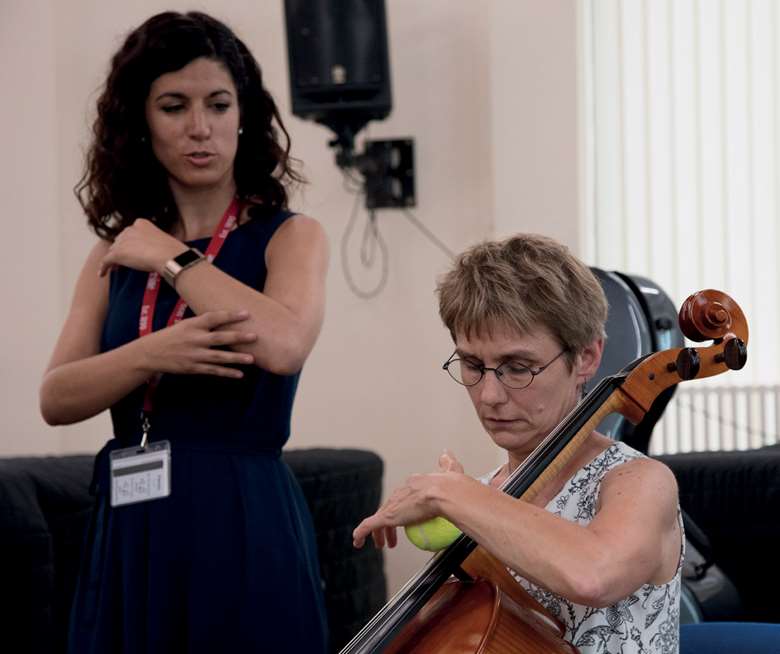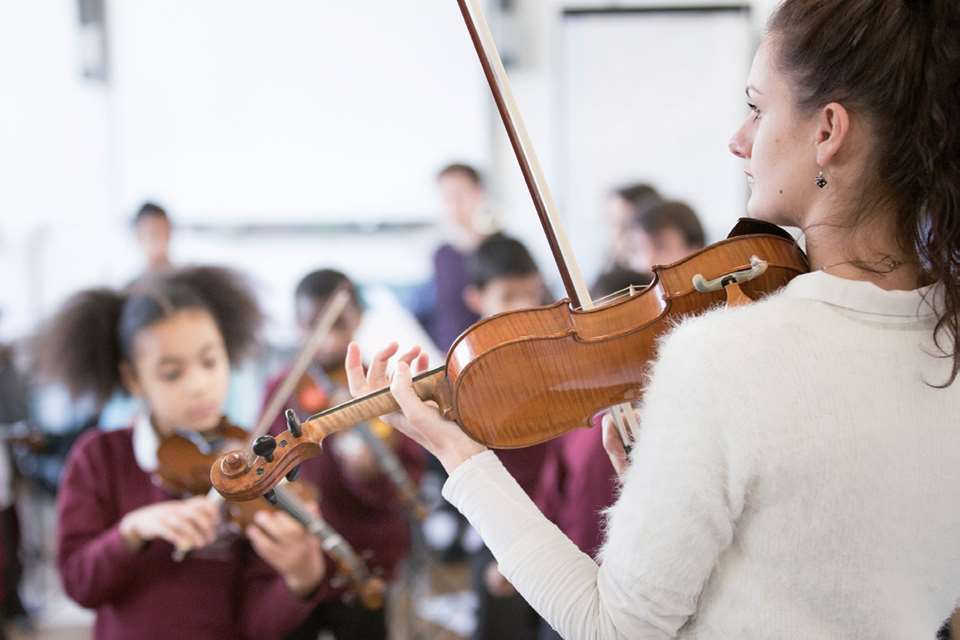ESTA’s mobile CPD
Phil Croydon
Sunday, October 1, 2023
MT’s Phil Croydon reports on ESTA’s burgeoning CPD offer, meeting staff and students.

Steve Bingham
ESTA, the European String Teaching Association, has long been part of the music education landscape, delivering CPD in the form of training days and an annual summer school. Around 10 years ago, it started branching out and today offers (among other courses) a PG Cert and Master’s degree in instrumental teaching, covering all instruments. The qualifications are validated by the University of Chichester.
The demand
I caught up with Helen Dromey, course leader for the ESTA PG Cert, who has been involved with the course since its inception in 2017. How did it start; what was the thinking? During discussion at one of ESTA’s summer course, Dromey explains, many felt something was missing, that there was a need for teachers ‘to learn how to teach, to continue getting better at what they do and for that to be recognised as something quite expert’. Richard Crozier (consultant), Laura Ritchie (from the University of Chichester) and Phil Aird (CEO of ESTA) took this and other ideas and designed a course for teachers, for all instruments.
Past students such as Allyxa Ruby agree that there was a gap in the market. ‘I have taught for many years and developed as a teacher and player. However, what I didn’t have was a formal string teaching qualification that proved my level of knowledge, playing ability and experience. I do think that as teachers we should always be looking to expand our knowledge, and gaining the PG Cert meant I could prove a certain level of knowledge and have confidence in me and my teaching to prospective students. I am aware that some teachers with minimal playing or teaching qualifications give instruction, and instrumental teaching ought to be more regulated, like the process with the PGCE.’
Instrumental teaching is, indeed, notoriously unregulated. But is there a desire among schools and colleges too, I ask, to address this? The picture is mixed. Dromey thinks some schools want a means of shortlisting when recruiting for jobs, and former students Allyxa Ruby and Paula Child seem underwhelmed by the level of interest shown by schools. Child, a classical guitar teacher for nearly 40 years, shared how she’d never had a lesson observed at schools where she worked.
All welcome, however, the fact that conservatoires are becoming aware of the sector’s need: to train students as teachers and, ultimately, equip the workforce. Instrumental music teaching, the profession, needs to be more joined up.
Modular design
The PG Cert is timetabled over one calendar year and delivered entirely online, with an option of attending a four-day residential course in the summer. It involves webinars, submitting videos of your teaching, and online work (synchronous or asynchronous). There’s also an extended essay and, importantly, one-to-one meetings covering all aspects of your teaching. Forums are where students get to speak with peers, sharing ideas; more often than not, with students of the same instrument.
Ruby and Child recorded that the workload was achievable but involved long hours, and (in the case of one) ‘juggling the day-job was a challenge, to put it mildly’. ESTA recommends putting aside 12–15 hours for study per week in order to get the maximum benefit from the course.
Both students, however, thought the course’s modular design and flexibility were exactly the right offer. ‘I started a term behind the rest of my cohort’, records Child, ‘but could immediately fit in’. Both also speak of patient and supportive course leaders.
Perhaps the most distinctive feature of the PG Cert is how it counts as RPL (requirements of prior learning) for the first four taught modules of ESTA’s MA in Practical Teaching – for those wishing to continue their journey. Successful completion of the PG Cert represents one third of this higher degree, which Andrew Somerville, MA course leader, describes as ‘a kind of top up’. The two courses dovetail nicely. The MA part is likewise part-time, timetabled over a period of two calendar years, and there’s further flexibility: ‘you could go off and teach for a couple of years, then put it all into practice, have a think, and do your Master’s later’, the team explain. If you successfully complete the PG Cert, you are automatically received onto the MA and you can return at any time; there’s no time limit.
Mentoring system
Mentors play a vital role across the PG Cert/MA, in one-to-one or group settings. Individual meetings occur weekly or fortnightly, and small groups meet to go through material from the webinars, which often pose a set of questions. Mentors take these forward while relating them to students’ individual teaching; ‘they’re also there to facilitate, as well as coach’, explains Dromey.
Unlike some teaching courses, the mentor is an instrument-specific supervisor. ESTA has a panel of 20+ mentors that includes household names (see ESTA’s website for details). ‘You’re working with someone who is really passionate and experienced at teaching your instrument’, adds Dromey.
For Child, this experience exceeded expectations: ‘The outstanding opportunity was learning from a team of highly-skilled, supportive and approachable staff. The guitar course mentor, Helen Sanderson, is completely passionate about teaching and is an outstanding educator and motivator. Her creativity knows no bounds. We continue to discuss the future of classical guitar teaching whenever we meet. It’s like I’m not on my own anymore; we’re regularly in touch.’
Student cohort
Students on the PG Cert (between 20 and 30 each year) typically come from all over, including Australia, America, Europe and Asia. Mandarin is heard at a number of sessions. Some students are at the beginning of their careers, some are established music teachers who want a change in direction (including on a new instrument), and some are incredibly well-established; ‘I’ve seen applications that make you think, is there anything I can possibly teach you?’, says Dromey. But they come to learn and reflect. ‘The course isn’t trying to make a certain kind of teacher for a certain kind of learning environment’, she adds.
For other students, this is a completely different career path, borne of a passion for their instrument and wanting to teach it. They may not have a music degree, and by their stage in life there’s no realistic way of returning to college or full-time education. ESTA, though, has the presence of mind to rely on interviews to determine a candidate’s true suitability and potential, based on high-level playing or teaching, for example. Phil Aird, who conducts the interviews, is pretty good at looking beyond qualifications.
There’s a strong awareness of the issues around access generally. Along with diversity and how to choose repertoire, this is covered across the PG Cert, and includes ‘understanding why certain students are doing particularly well and how this might relate to the way you teach’, explains Dromey. This leads to a wider, philosophical point: ‘Some teachers were very fortunate to receive excellent teaching, but others less so, and this is perpetuated when they unthinkingly teach as they were taught. We’re not only aiming to understand what constitutes good teaching, but also how to move teaching forward. I’d like to think the teachers on this course feel confident that their teaching is relevant and caters for all students, not just the small percentage of children who will probably do well anywhere.’
Final thoughts
‘It’s the luxury of time to come and reflect on what you do; to see what you really do’, explains Dromey, when asked to describe the main benefits of the PG Cert. Students identify gaps, compare notes with others doing the same job (including in different settings) and are supported in their journeys. Former students Ruby and Child attest to a ‘togetherness’.
I admit, I was skeptical about a teaching course being entirely online, particularly after the lockdowns of recent years. Teaching and music are social activities, and not everyone has fun being on camera or scrutinising colleagues’ tastes in wallpaper. But considering the pressures of workplace and other commitments, our carbon footprints, and the shortage of good teachers, there’s a compelling argument for doing things differently. ‘Having all the resources online, in one place, so that you can watch them whenever you want, however many times you want’ is a great advantage, says Dromey. The former students tend to agree.
Happily, there seems to be a growing consensus that the UK is leading the way in providing CPD for instrumental music teachers. If this trend is to continue, we probably need more modular, flexible, accessible courses of this sort. Then the regulation can follow.




